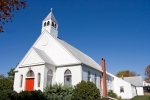January 15, 2014
Praying Facebook
 Years ago, someone started a Facebook page for our congregation. At the time, I didn’t know much about social media – I didn’t even have my own Facebook account – so I just followed their lead and we learned by trial and error. In time I learned how to post articles and pictures, share news and updates, and keep connected to others and, hopefully, keep them connected to us.
Years ago, someone started a Facebook page for our congregation. At the time, I didn’t know much about social media – I didn’t even have my own Facebook account – so I just followed their lead and we learned by trial and error. In time I learned how to post articles and pictures, share news and updates, and keep connected to others and, hopefully, keep them connected to us.
And then I did something which, as the Facebook report informs me, changed the game. I posted a prayer.
That doesn’t sound so radical, does it? We’ve got great prayers in our Book of Common Prayer, after all, and that was one of the things that attracted me to the Episcopal Church – that not only is our life rooted in prayer but also those prayers are time-tested, emerging from the ages, speaking to universal concerns and not just echoing one person’s individual agenda or lone-ranger thinking. Even those prayers which have been composed fairly recently nevertheless have the patina of the eternal. There’s good reason we spend a lot of time teaching our Sunday School kids and seminarians how to construct a truly good Collect.
It doesn’t sound so new or hip but good prayers are, apparently, refreshing. It is, at least, to those who scroll through their social media news feed several times each day. Out of a total of 220 “Likes,” we get decent response when we post links to news or events (average reach for those seems to be 40ish), pretty lousy response to event invitations (hovering around the low teens) and around 50 or so people check out our Facebook link to the church’s weekly Constant Contact newsletter. But the numbers literally spike – well over 200, on average – when we post nothing more than a well-chosen prayer!
At least several times each week, then, we post a prayer and cite its source. Most often, we lift a collect from the Daily Offices or from the ‘Prayers and Thanksgivings’ section in the back of the BCP (p. 810 and following) or from other prayer books, especially those in the wider Anglican worldwide family. The number of responses confirm for us that people respond best when we connect the prayer post to the particular day or season or hour – late at night we borrow from Compline, for instance. In turn, we’ve also learned from trial and error that responses are not so great when we’ve included what I’ll call those more heavy-handed Collects, those that are clearly trying to make a more concerted theological point about, say, a given day’s saint.
The limitations of having a Facebook page (as opposed to a group) are, for us, set against the fact that a Page enables us to “See Insights” and get a better handle on who’s interested in what and when and why.
We haven’t delved into paying for Facebook ads and I suspect we won’t be going there anytime soon, chiefly because there’s something intrinsically qualitative and downright real about what Facebook describes as “organic reach.” Organic reach, they say, is “the number of unique people who saw your post in News Feed or on your Page, including people who saw it from a story shared by a friend when they liked, commented on or shared your post.” So not only do our parishioners seem to like (and “Like”) the random prayer posts but, in so doing, their friends (and “Friends” ) see that and, I’ll wager, begin to have positive associations for the church whose sole interest is praying and sharing prayer – not necessarily advertising events or trying to get people into their pews.
So many people are clearly searching for a way to pray their day, nothing more, nothing less. The church can be in the business of that.





